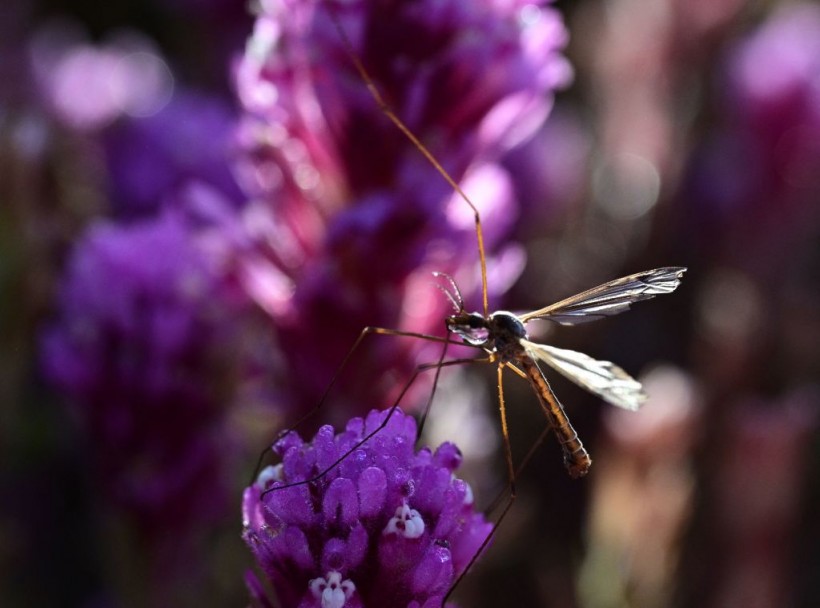Daddy longlegs are familiar creatures that can be found in many parts of the world. They are often seen in dark and moist places, such as under rocks, logs, or leaves.
They have long and slender legs that give them their common name, but they are not true spiders. In fact, they belong to a different order of arachnids called Opiliones, which includes about 10,000 species.
Daddy longlegs are not spiders, but they are related to scorpions
 (Photo : ROBYN BECK/AFP via Getty Images)
(Photo : ROBYN BECK/AFP via Getty Images)

One of the most common misconceptions about daddy longlegs is that they are spiders. However, they have several features that distinguish them from spiders and other arachnids. For example:
- Daddy longlegs have a single body segment, while spiders have two (cephalothorax and abdomen).
- Daddy longlegs have two eyes on top of their body, while spiders have six or eight eyes on the front of their head.
- They do not have venom glands or fangs, while spiders use venom and fangs to subdue their prey.
- They do not produce silk or spin webs, while spiders use silk for various purposes, such as building webs, wrapping prey, or making egg sacs.
Daddy longlegs are more closely related to scorpions than to spiders. They share a common ancestor with scorpions that lived about 435 million years ago, as per Phys.org.
They also share some characteristics with scorpions, such as having a pair of pedipalps (appendages near the mouth) that can be used for sensing, feeding, or mating.
Daddy longlegs are ancient and diverse
Daddy longlegs are among the oldest and most diverse groups of arachnids. They have a fossil record that dates back to the Silurian period, about 400 million years ago.
Some of the oldest fossils of daddy longlegs look very similar to modern ones, suggesting that they have changed little over time.
However, they have also diversified into many different forms and lifestyles.
These creatures can be found on every continent except Antarctica. They inhabit a variety of habitats, from tropical forests to deserts to caves. They can be active during the day or night, depending on the species.
They can also vary in size, color, and shape. Some species have very short legs, while others have very long ones.
Some species are brightly colored or patterned, while others are dull or camouflaged. Some species have elaborate ornaments or appendages on their body or legs, such as spines, horns, or claws.
Daddy Longlegs also have diverse diets and behaviors. Most species are omnivorous or scavengers, feeding on plant matter, fungi, carrion, or other invertebrates.
Some species are predators or parasites, hunting or feeding on other arachnids, insects, snails, or worms.
Meanwhile, some species are social or communal, living in large groups or sharing nests. Some species are solitary or territorial, defending their own space or resources.
Also Read: Daddy Longlegs: Do These Spiders Have the Most Powerful Venom in the World?
Daddy longlegs have unique adaptations
Daddy longlegs have evolved some unique adaptations that help them survive and thrive in their environments. For example:
- They can detach their legs when threatened by predators or parasites. The detached leg can twitch for several minutes to distract the attacker while the daddy longleg escapes. However, the lost leg does not grow back and may affect the daddy longleg's mobility or balance, as per Treehugger.
- Daddy longlegs can produce defensive chemicals from glands on their body or legs. These chemicals can deter predators or parasites by emitting foul odors or tastes. Some chemicals can even cause blisters or burns on the skin of predators.
- They can communicate with each other using vibrations, sounds, pheromones, or visual signals. They can use these signals for various purposes, such as finding mates, warning others of danger, or establishing dominance.
Related article: How Daddy-Longlegs Catch the Uncatchable
© 2024 NatureWorldNews.com All rights reserved. Do not reproduce without permission.

![Tsunami Hazard Zones: New US Map Shows Places at Risk of Flooding and Tsunamis Amid Rising Sea Levels [NOAA]](https://1471793142.rsc.cdn77.org/data/thumbs/full/70325/280/157/50/40/tsunami-hazard-zones-new-us-map-shows-places-at-risk-of-flooding-and-tsunamis-amid-rising-sea-levels-noaa.jpg)



